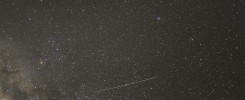July 2023
Very-high-energy (VHE) gamma-rays studied with the H.E.S.S. telescopes are emitted by charged particles (mostly electrons and protons) that have been accelerated to very high energies. This ties gamma-rays to these highly relativistic charged particles – known since more than 100 years as ‘Cosmic Rays’. While the efficiency of acceleration processes depends on the mass of the particle, the acceleration as such does not discriminate between positive and negative charge. Despite their different masses, one hence expects the acceleration processes to provide highly relativistic electrons and protons. Once accelerated, there is an important difference between electrons and protons: While the former will lose their energy through electromagnetic radiation, protons will also suffer energy losses by colliding with atomic nuclei in the interstellar medium. Such collisions will result in the emission of Neutrinos of very high energies. Sites of gamma-ray emission may hence also give rise to high-energy neutrinos.
After long-lasting searches Neutrino Observatories – operated deep underwater or in antarctic ice – have been able to detect neutrinos and separate neutrinos of astrophysical origin with a certain individual statistical probability from the more numerous neutrinos generated in the Earth and its atmosphere.
Ever since the detection of neutrinos of astrophysical origin [1], it has been a real challenge to identify sources of neutrinos and to determine whether they are – in fact – emitted by any discrete astrophysical source or rather result from random interactions of cosmic rays traversing the Universe and interacting individually somewhere in interstellar or intergalactic space rather than pointing back to a cosmic accelerator. This task is tedious due to the poor localisation of individual neutrinos. Furthermore, neutrinos do not show significant clustering but are mostly distributed randomly on the sky (see Fig. 1). The main hope lies in finding clusters of neutrinos in space and/or arrival time that point to steady sources or explosive events that are identified in other waveband regimes. H.E.S.S. and many other observatories have tried to facilitate such searches for neutrino counterparts by searching for unusual gamma-ray signals associated with the detection of individuals highly energetic neutrinos.

This week, in July 2023, a study was published describing the joint efforts of the H.E.S.S. collaboration teaming up with the VERITAS collaboration to identify the source of a 170 TeV neutrino candidate reported by the IceCube collaboration, operating the most sensitive current generation neutrino detector at the South Pole ([2]).

The neutrino candidate, IceCube-211208A, was recorded on December 8, 2021 as a so-called track-like event of a 170 TeV particle and reconstructed with an angular uncertainty of about 14 square degrees. The likelihood that the candidate is a true astronomical neutrino is about 30% ([3]). This rather low probability for neutrino emission from this region at this time is enhanced slightly by the detection of three other neutrinos reported to have been detected by the Baikal-, the Km3Net- and the Baskan- Neutrino observatories ([2]). Unfortunately, the likelihood of these candidates to be of astrophysical origin is either lower or not reported at all. Within the large uncertainty region of the IceCube-211208A candidate several potential emitters of astrophysical neutrinos can be found. One may expect, however, that the probability of neutrino detection is enhanced if the source emitting the neutrinos is particularly active as a source of high energy electromagnetic radiation (i.e. gamma rays) at the same time. In early December 2021, the quasar PKS 0735+178 was rather active. It is located slightly outside of the 90% error circle of the IceCube-211208A candidate. Nonetheless the combined motivation of an increased emission of GeV gamma-rays (recorded by Fermi) and optical emission (recorded e.g. with ATOM, Fig. 2) and the detection of a potential astronomical neutrino prompted VHE gamma-ray observations with the HESS and VERITAS arrays. The observations did not yield a detection but provided constraints to models describing the spectral energy distribution of PKS 0735+178 (Fig. 3). A model that describes the electromagnetic radiation well would indeed allow for the emission of astrophysical neutrinos. Their expected rate is so low, however, that it falls below the upper limit on the neutrino flux deduced from the neutrino candidate potentially associated with PKS 0735+178 (single neutrinos are insufficient to deduce a rate (or flux) and can only be used to infer limits under specific assumptions).

As in the case of TXS 0506+056 ([4], SOM 2018/08), the biggest problem remains the rather high probability that the neutrinos candidates triggering the respective observations are actually not of astrophysical origin at all. Significant detections of sources of astrophysical neutrinos hence still remain elusive despite recent promising indications for neutrinos from the starburst/Seyfert galaxy NGC 1068 or the Galactic plane ([5]).
References:
[1] IceCube collaboration, et al., 2013, Science, 342, 1242856
[2] VERITAS collaboration, HESS collaboration, et al., 2023, ApJ, in press
[3] IceCube collaboration, 2021, GCN.31191
[4] IceCube collaboration, et al., 2018, Science, 361, eaat1378
[5] Aartsen, M.G., et al., 2020, PhRvL, 124, 051103 and Abbasi, R., et al., 2023, Science,380, 6652
[6] Buson, S., et al., 2022, ApJL, arxiv 2207.06314


